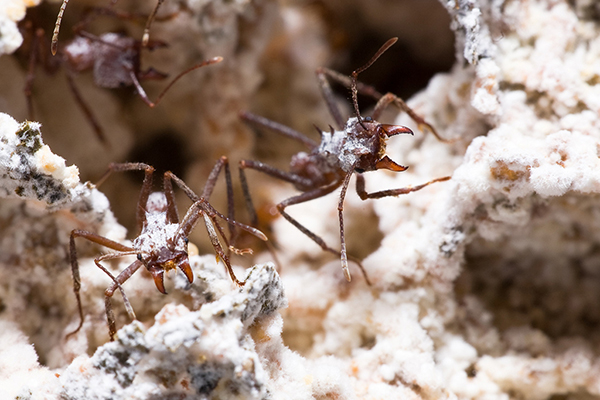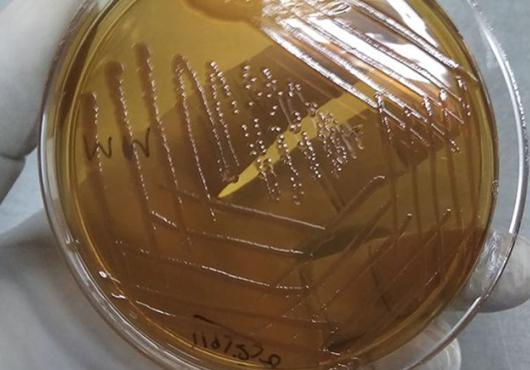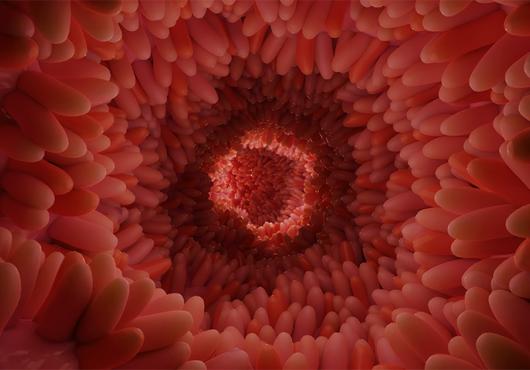
In the Atlantic Forest of Brazil, leaf-cutter ants carry fresh foliage back to their home colony. There, the partially digested leaves nourish a “garden” of white fungus that the ants cultivate to feed their larvae, their queen and other ants that never leave the nest.
Like human gardeners, the fungus-farming ants must protect their crop from invaders. The parasitic fungus Escovopsis poses a constant threat. Fortunately, the ants have an ally: Pseudonocardia bacteria.
During more than 45 million years of symbiosis with the ants, the bacteria have evolved to produce specific antifungal compounds that kill invading Escovopsis while sparing the good fungus. Many of the ants, meanwhile, have evolved special pockets and glands in their bodies to house and feed their bacterial partners.
A team of scientists from the U.S. and Brazil hopes that studying the compounds these bacteria produce will lead to new drugs that combat invasive fungal infections in people, as well as new treatments for cancer and parasitic diseases.
The idea is rooted in history. Pseudonocardia belongs to a group of actinobacteria that has already provided most of the world’s antibiotics as well as antifungals, antivirals, anti-clotting drugs and more. And the fungus they fight for the ants is related to fungi that cause life-threatening human disease.
To date, no one has gone hunting for natural products—compounds made by living organisms that could serve as or inspire medicines—in the fungus-farming ant ecosystems.
The National Institutes of Health and the State of São Paulo Research Foundation share the scientists’ belief that these ecosystems have medicinal potential. On July 31, they awarded the team $5,154,376 over five years.
“I’m very excited. I think this project has a good chance of success, and I think it aligns ecology and drug discovery in a way that we haven’t tried before,” said Jon Clardy, the Hsien Wu and Daisy Yen Wu Professor of Biological Chemistry and Molecular Pharmacology at Harvard Medical School, who will co-lead the project with medicinal chemist Monica Pupo of the University of São Paulo.
The roster of team members includes Cameron Currie, an evolutionary field biologist at the University of Wisconsin who discovered the role of actinobacteria in helping insects fight pathogens; infectious disease and mycology expert David Andes and medicinal chemist Timothy Bugni, also from the University of Wisconsin; and James Bradner, HMS assistant professor of medicine at the Dana-Farber Cancer Institute, a hematologist and chemical biologist with an interest in cancer.
“Incredible opportunity”
More than 200 kinds of fungus-farming ants live in South and Central America. Many of them make their homes in the diverse biomes of Brazil. Each colony may host a slightly different strain of bacteria that makes slightly different compounds to fight a slightly different fungal invader.
“We have an incredible opportunity to rigorously evaluate biodiversity in the context of therapeutic discovery and ecology,” said Clardy.
The team’s main focus will be discovering antifungal agents.
The world is in desperate need of new antifungal medicines. Invasive fungal infections—those that spread inside the body, as opposed to superficial infections of the skin and nails—are on the rise, new strains are emerging and infections are increasingly resistant to existing drugs.
“Worldwide, more people die of invasive fungal diseases than die of malaria or tuberculosis,” said Clardy. “What’s scary is it’s not widely appreciated how dangerous these diseases are because the incidence is quite low, but the mortality is typically very high.”
Aspergillosis, for example, may only affect about 200,000 people worldwide, but it has a mortality rate of anywhere from 30 to 95 percent. Fungal infections are a top cause of infection-related death in cancer and transplant patients.
Clardy and team believe that studying ecosystems that resemble a specific clinical need, instead of the more common natural-products discovery method of collecting random samples in a diverse environment, will hasten the identification of compounds that can treat the target condition.
Clardy emphasized the importance of two funding collaboratives for the research: The International Cooperative Biodiversity Groups Program (ICBG), co-funded by the NIH and National Science Foundation, and the NIH’s John E. Fogarty International Center. They required applicants to define the therapeutic areas for which new drugs are needed and align those with an ecological rationale for finding molecules with the desired properties.
In addition to antifungals, the team will look for natural products that could become anti-cancer drugs. Many chemotherapeutics act in a similar way to antifungals: They spare slower-growing cells (like those of ants, beneficial fungi and humans) while killing faster-growing cells (like those of invading fungi and tumors). In fact, many chemotherapy drugs were originally developed as antifungals, including the immune suppressor rapamycin (Sirolimus), which was found in soil-dwelling actinobacteria on Easter Island.
The team’s third goal involves searching for antiparasitics to help treat Chagas disease, also known as the New World version of African sleeping sickness, and leishmaniasis, both of which the World Health Organization has named neglected tropical diseases. Chagas disease is a particular burden in Brazil, where it has infected 4 million people and kills as many each year as tuberculosis.
Nature’s medicines
The researchers will collect samples each year from insect colonies in some of Brazil’s most richly biodiverse areas, starting with two of the most threatened: the Atlantic Forest and Cerrado tropical grassland.
They will cultivate the bacteria they find and screen around 500 strains a year, looking for compounds that “have the desirable activity, are made in a reasonable amount and have an interesting mechanism of action,” said Clardy.
Metabolomic tests will reveal the compounds each strain of bacteria makes under certain environmental conditions. Genome sequencing will indicate the full range of compounds that the bacteria are capable of making.
Along the way, the researchers will add each natural product they isolate to a library for other scientists to use.
The team also plans to collect fungus-fighting bacteria associated with other social insects in the region, such as termites, wasps or stingless bees.
A recent collaboration among Pupo, Clardy and Currie has had promising results. They cultured fewer than 200 kinds of insect-associated actinobacteria and found 20 never-before-seen natural products.
Clardy has previously discovered numerous natural products made by the symbiotic bacteria of ants, beetles and mound-building termites, with an eye toward treating infectious tropical diseases such as malaria and African sleeping sickness. He has collaborated with Currie for about six years, and Pupo was once a postdoc in his lab.
However, this is the first time Clardy will conduct research in Brazil. Besides the hunt for new drugs, a major goal of the project is to train Brazilian students and young scientists in interdisciplinary natural product discovery and expand the country’s research capacity.
In recent years, natural-product discovery has taken a backseat to high-throughput screening of largely synthetic compounds. That’s in part because natural products can be expensive; they are made in small quantities; and seekers tend to sample the same kind of bacteria in the same environments, leading to rediscovery of the same compounds.
While high-throughput screening has its place, the beauty of natural products, said Clardy, is that they have an evolutionary history of success—nature’s clinical trials.
“These compounds have gone through rounds of modification, selection and expansion to fulfill a specific biological function,” he said. “I think there’s good evidence that there’s a lot of undiscovered stuff out there.”
This project is supported by the National Institutes of Health (National Center for Complementary and Alternative Medicine, National Institute of General Medical Sciences, National Cancer Institute and John E. Fogarty International Center), the National Science Foundation and the São Paulo Research Foundation (FAPESP).





